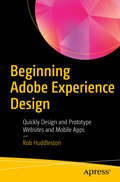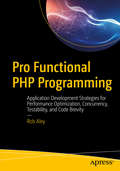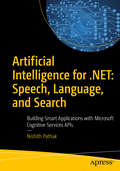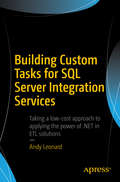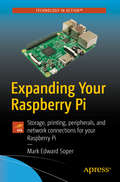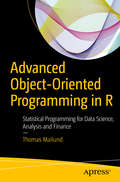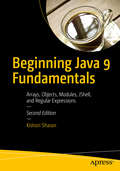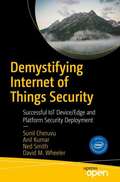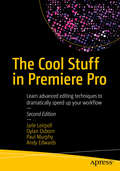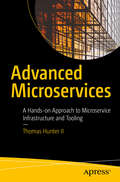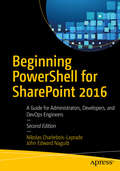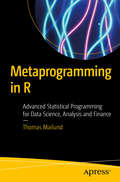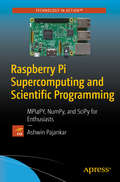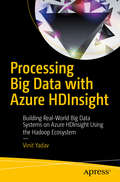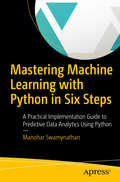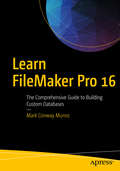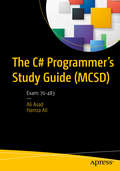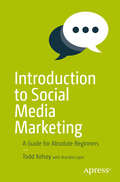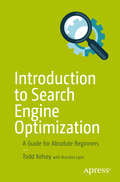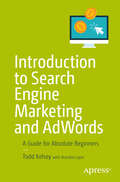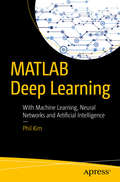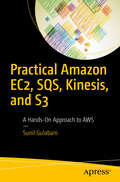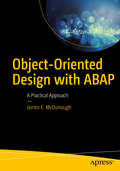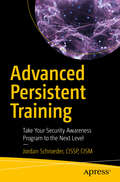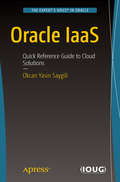- Table View
- List View
Beginning Adobe Experience Design: Quickly Design and Prototype Websites and Mobile Apps
by Rob HuddlestonRender high quality designs and interactive prototypes of web sites and mobile apps using Adobe XD's powerful drawing and layout tools. This book provides an in-depth look at XD and shows you how to quickly get up-to-speed to simplify these processes with intuitive design tools and a powerful prototyping function. Since the advent of the web, designers have struggled with the need to create functioning demo prototypes of their layouts and designs without an extensive amount of code for their clients. The dawn of mobile apps, which are exponentially more difficult to mock-up and demonstrate, has only intensified this problem. Beginning Adobe Experience Design resolves this for you with it's easy-to-use approach to leveraging XD. What You'll LearnCreate links and interactivity to see just how your site or app will functionPreview your site or prototype live in a web browser or your mobile deviceUse Adobe XD on both Mac and WindowsWho This Book Is ForWeb front-end designers and user experience professionals and educators interested in teaching the tool
Pro Functional PHP Programming
by Rob AleyBring the power of functional programming to your PHP applications. From performance optimizations to concurrency, improved testability to code brevity, functional programming has a host of benefits when compared to traditional imperative programming. Part one of Pro Functional PHP Programming takes you through the basics of functional programming, outlining the key concepts and how they translate into standard PHP functions and code. Part two takes this theory and shows you the strategies for implementing it to solve real problems in your new or existing PHP applications. Functional programming is popular in languages such as Lisp, Scheme and Clojure, but PHP also contains all you need to write functional code. This book will show you how to take advantage of functional programming in your own projects, utilizing the PHP programming language that you already know. What You'll Learn Discover functional programming in PHP Work with functional programming functions Design strategies for high-performance applications Manage business logic with functions Use functional programming in object-oriented and procedural applications Employ helper libraries in your application Process big data with functional PHP Who This Book Is For Programmers and web developers with experience of PHP who are looking to get more out of their PHP coding and be able to do more with PHP.
Artificial Intelligence for .NET: Building Smart Applications with Microsoft Cognitive Services APIs
by Nishith PathakGet introduced to the world of artificial intelligence with this accessible and practical guide. Build applications that make intelligent use of language and user interaction to better compete in today's marketplace. Discover how your application can deeply understand and interpret content on the web or a user's machine, intelligently react to direct user interaction through speech or text, or make smart recommendations on products or services that are tailored to each individual user. With Microsoft Cognitive Services, you can do all this and more utilizing a set of easy-to-use APIs that can be consumed on the desktop, web, or mobile devices. Developers normally think of AI implementation as a tough task involving writing complex algorithms. This book aims to remove the anxiety by creating a cognitive application with a few lines of code. There is a wide range of Cognitive Services APIs available. This book focuses on some of the most useful and powerful ways that your application can make intelligent use of language. Artificial Intelligence for . NET: Speech, Language, and Search will show you how you can start building amazing capabilities into your applications today. What You'll Learn Understand the underpinnings of artificial intelligence through practical examples and scenarios Get started building an AI-based application in Visual Studio Build a text-based conversational interface for direct user interaction Use the Cognitive Services Speech API to recognize and interpret speech Look at different models of language, including natural language processing, and how to apply them in your Visual Studio application Reuse Bing search capabilities to better understand a user's intention Work with recommendation engines and integrate them into your apps Who This Book Is For Developers working on a range of platforms, from . NET and Windows to mobile devices. Examples are given in C#. No prior experience with AI techniques or theory is required.
Building Custom Tasks for SQL Server Integration Services
by Andy LeonardLearn to build custom SSIS tasks using Visual Studio Community Edition and Visual Basic. Bring all the power of Microsoft . NET to bear on your data integration and ETL processes, and for no added cost over what you've already spent on licensing SQL Server. If you already have a license for SQL Server, then you do not need to spend more money to extend SSIS with custom tasks and components. Why are custom components necessary? Because even though the SSIS catalog of built-in tasks and components is a marvel of engineering, there do remain gaps in the functionality that is provided. These gaps are especially relevant to enterprises practicing Data Integration Lifecycle Management (DILMS) and/or DevOps. One of the gaps is a limitation of the SSIS Execute Package task. Developers using the stock version of that task are unable to select SSIS packages from other projects. Yet it's useful to be able to select and execute tasks across projects, and the example used throughout this book will help you to create an Execute Catalog Package task that does in fact allow you to execute a task from another project. Building on the example's pattern, you can create any task that you like, custom tailored to your specific, data integration and ETL needs. What You Will Learn Configure and execute Visual Studio in the way that best supports SSIS task development Create a class library as the basis for an SSIS task, and reference the needed SSIS assemblies Properly sign assemblies that you create in order to invoke them from your task Implement source code control via Visual Studio Team Services, or your own favorite tool set Code not only your tasks themselves, but also the associated task editors Troubleshoot and then execute your custom tasks as part of your own project Who This Book Is For Database administrators and developers who are involved in ETL projects built around SQL Server Integration Services (SSIS). Readers should have a background in programming along with a desire to optimize their ETL efforts by creating custom-tailored tasks for execution from SSIS packages.
Expanding Your Raspberry Pi
by Mark Edward SoperGain a deeper understanding of how Raspberry Pi works to get the results you want right in the palm of your hand. This book helps you understand the right connections and software to drive your Raspberry Pi into opening the worlds of programming, electronic experiments, system control, digital imaging, and the Internet of Things to you. You'll discover how to expand your Pi's storage for bigger programs, use its onboard connections to interface with cameras and control devices, printers and scanners. You'll also see how to share information with Windows and Apple computers and mobile devices, and use it away from AC power. You'll be able to turn any HDTV into a media player; stream and share files from desktop and mobile devices; use your Pi for image capture via camera or scanner; and more! Expanding Your Raspberry Pi is your guide to doing almost anything a bigger computer can do - if you're ready for the challenge. What You'll Learn Connect, use, and manage mass storage devices for greater versatility Link with desktop, laptop, and mobile devices using the Pi's built-in Wi-Fi and Bluetooth features Share resources from your Pi with desktop and mobile devices Capture video and still photos with your Pi Who This Book Is For Network administrators: Connect Raspberry Pi devices to other devices on a wired or wireless network for media streaming, file serving, or print serving Teachers: Use Raspberry Pi to teach students how to connect different types of computers and operating systems with each other. IT workers: Use Raspberry Pi with your existing printers, scanners, webcams, and home network
Advanced Object-Oriented Programming in R: Statistical Programming for Data Science, Analysis and Finance
by Thomas MailundLearn how to write object-oriented programs in R and how to construct classes and class hierarchies in the three object-oriented systems available in R. This book gives an introduction to object-oriented programming in the R programming language and shows you how to use and apply R in an object-oriented manner. You will then be able to use this powerful programming style in your own statistical programming projects to write flexible and extendable software. After reading Advanced Object-Oriented Programming in R, you'll come away with a practical project that you can reuse in your own analytics coding endeavors. You'll then be able to visualize your data as objects that have state and then manipulate those objects with polymorphic or generic methods. Your projects will benefit from the high degree of flexibility provided by polymorphism, where the choice of concrete method to execute depends on the type of data being manipulated. What You'll Learn Define and use classes and generic functions using R Work with the R class hierarchies Benefit from implementation reuse Handle operator overloading Apply the S4 and R6 classes Who This Book Is For Experienced programmers and for those with at least some prior experience with R programming language.
Beginning Java 9 Fundamentals: Arrays, Objects, Modules, JShell, and Regular Expressions
by Kishori SharanLearn the basics of Java 9, including basic programming concepts and the object-oriented fundamentals necessary at all levels of Java development. Author Kishori Sharan walks you through writing your first Java program step-by-step. Armed with that practical experience, you'll be ready to learn the core of the Java language. Beginning Java 9 Fundamentals provides over 90 diagrams and 240 complete programs to help you learn the topics faster. The book continues with a series of foundation topics, including using data types, working with operators, and writing statements in Java. These basics lead onto the heart of the Java language: object-oriented programming. By learning topics such as classes, objects, interfaces, and inheritance you'll have a good understanding of Java's object-oriented model. The final collection of topics takes what you've learned and turns you into a real Java programmer. You'll see how to take the power of object-oriented programming and write programs that can handle errors and exceptions, process strings and dates, format data, and work with arrays to manipulate data. This book is a companion to two other books also by Sharan focusing on APIs and advanced Java topics. What You'll Learn Write your first Java programs with an emphasis on learning object-oriented programming in Java Work with data types, operators, statements, classes and objects Handle exceptions, assertions, strings and dates, and object formatting Use regular expressions Work with arrays, interfaces, enums, and inheritance Deploy Java applications on memory-constrained devices using compact profiles Take advantage of the new JShell REPL tool Who This Book Is For Those who are new to Java programming, who may have some or even no prior programming experience.
Demystifying Internet of Things Security: Successful IoT Device/Edge and Platform Security Deployment
by Anil Kumar Sunil Cheruvu Ned Smith David M. WheelerBreak down the misconceptions of the Internet of Things by examining the different security building blocks available in Intel Architecture (IA) based IoT platforms. This open access book reviews the threat pyramid, secure boot, chain of trust, and the SW stack leading up to defense-in-depth.The IoT presents unique challenges in implementing security and Intel has both CPU and Isolated Security Engine capabilities to simplify it. This book explores the challenges to secure these devices to make them immune to different threats originating from within and outside the network. The requirements and robustness rules to protect the assets vary greatly and there is no single blanket solution approach to implement security.Demystifying Internet of Things Security provides clarity to industry professionals and provides and overview of different security solutionsWhat You'll LearnSecure devices, immunizing them against different threats originating from inside and outside the networkGather an overview of the different security building blocks available in Intel Architecture (IA) based IoT platformsUnderstand the threat pyramid, secure boot, chain of trust, and the software stack leading up to defense-in-depthWho This Book Is ForStrategists, developers, architects, and managers in the embedded and Internet of Things (IoT) space trying to understand and implement the security in the IoT devices/platforms.
The Cool Stuff in Premiere Pro
by Jarle Leirpoll Dylan Osborn Paul Murphy Andy EdwardsGain in-depth knowledge of Premiere Pro, and learn how the software "thinks. " You'll acquire new skills that will help you choose the best workflow for your project, and simplify and accelerate your video editing process. Learn how you can edit a lot faster with smarter workflows that automate several steps in the editing process. You'll also see how custom settings, presets, keyboard shortcuts and templates saves hours of work. By tailoring the software to your needs you save clicks on just about every task. With many traditional jobs now being done by one person, its important to understand audio smoothing, color grading, motion graphics, and advanced editing techniques. You'll learn these skills and disciplines and see how they'll enhance your project's workflow. All the authors are professional editors and want to know exactly how to cut your film as fast as possible with top quality output. There is invaluable information in The Cool Stuff in Premiere Pro that's not available anywhere else - not even in Adobe's own manuals. What You'll Learn Edit faster, no matter what the project Understand the technical stuff, like timeline settings, render codecs, color subsampling, export settings, effect controls and monitor settings Know when to send your clips to other Adobe software, and how to treat them there. Master the Premiere Pro timeline, even stacks of timelines, and edit, trim and adjust with ease Who This Book Is For Video journalists (and everyone else) will learn how to edit faster and get home in time for dinner. Bloggers will learn how to make their online video and audio "pop". Film cutters will learn how to organize, rough cut and fine tune huge amounts of material effectively and how to output for digital cinema. Experienced video editors will learn how to deal with multi-track audio and to work faster in every step of the edit. Marketing people who edit video for social media and web pages will learn simpler ways to make a faster cut. Teachers in media studies will understand the logic in Premiere Pro, and be better prepared for teaching video editing.
Advanced Microservices: A Hands-on Approach to Microservice Infrastructure and Tooling
by Thomas Hunter IIUse the many types of tools required to navigate and maintain a microservice ecosystem. This book examines what is normally a complex system of interconnected services and clarifies them one at a time, first examining theoretical requirements then looking at concrete tools, configuration, and workflows. Building out these systems includes many concerns such as containerization, container orchestration, build pipelines and continuous integration solutions, automated testing, service discovery, logging and analytics. You will examine each of these tools and understand how they can be combined within an organization. You will design an automated build pipeline from Pull Request to container deployment, understand how to achieve High Availability and monitor application health with Service Discovery, and learn how to collaborate with other teams, write documentation, and describe bugs. Covering use of Jenkins, Docker, Kubernetes, the ELK stack (Elasticsearch, Logstash, and Kibana), and StatsD and Grafana for analytics, you will build on your existing knowledge of Service-Oriented Architecture and gain an advanced, practical understanding of everything from infrastructure development to team collaboration. What You'll Learn Design an API to be convenient for developers to consume. Deploy dynamic instances of Microservices and allow then to discover each other. Track the health of a Microservice and be notified in case of degraded performance. Write effective documentation and communicate efficiently with other teams. Who This Book Is For Those who would like a better understanding of System Oriented Architecture. Those who would like to break a monolith into smaller Microservices. Those who are familiar with Microservices and would like a better understanding of peripheral technologies.
Beginning PowerShell for SharePoint 2016: A Guide for Administrators, Developers, and DevOps Engineers
by Nikolas Charlebois-Laprade John Edward NaguibUse the latest tools to manage and automate tasks on Microsoft's SharePoint platform. You will achieve time and cost savings, increase reliability of deployments, and learn how to safely and efficiently migrate from a previous version, all while gaining valuable skills in PowerShell scripting. Authors Nik Charlebois-Laprade and John Edward Naguib begin by explaining the fundamental concepts behind the PowerShell language. Then, with copious real-world examples and scripts, they introduce PowerShell operations in the context of deploying, migrating, managing, and monitoring SharePoint 2016. What You'll Learn What's New in this Edition? Learn about the new SharePoint 2016 capabilities and min role Extend the default set of available PowerShell cmdlets for SharePoint 2016 by creating your own reusable Cmdlet functions with PowerShell 5. 0 Upgrade your on-premises SharePoint 2013 environment to SharePoint 2016 using PowerShell Who This Book Is For Administrators, developers, and DevOps engineers working with SharePoint 2016. No experience with PowerShell is required.
Metaprogramming in R
by Thomas MailundLearn how to manipulate functions and expressions to modify how the R language interprets itself. This book is an introduction to metaprogramming in the R language, so you will write programs to manipulate other programs. Metaprogramming in R shows you how to treat code as data that you can generate, analyze, or modify. R is a very high-level language where all operations are functions and all functions are data that can be manipulated. This book shows you how to leverage R's natural flexibility in how function calls and expressions are evaluated, to create small domain-specific languages to extend R within the R language itself. What You'll Learn Find out about the anatomy of a function in R Look inside a function call Work with R expressions and environments Manipulate expressions in R Use substitutions Who This Book Is For Those with at least some experience with R and certainly for those with experience in other programming languages.
Raspberry Pi Supercomputing and Scientific Programming
by Ashwin PajankarBuild an inexpensive cluster of multiple Raspberry Pi computers and install all the required libraries to write parallel and scientific programs in Python 3. This book covers setting up your Raspberry Pis, installing the necessary software, and making a cluster of multiple Pis. Once the cluster is built, its power has to be exploited by means of programs to run on it. So, Raspberry Pi Supercomputing and Scientific Programming teaches you to code the cluster with the MPI4PY library of Python 3. Along the way, you will learn the concepts of the Message Passing Interface (MPI) standards and will explore the fundamentals of parallel programming on your inexpensive cluster. This will make this book a great starting point for supercomputing enthusiasts who want to get started with parallel programming. The book finishes with details of symbolic mathematics and scientific and numerical programming in Python, using SymPi, SciPy, NumPy, and Matplotlib. You'll see how to process signals and images, carry out calculations using linear algebra, and visualize your results, all using Python code. With the power of a Raspberry Pi supercomputer at your fingertips, data-intensive scientific programming becomes a reality at home. What You Will Learn Discover the essentials of supercomputing Build a low-cost cluster of Raspberry Pis at home Harness the power of parallel programming and the Message Passing Interface (MPI) Use your Raspberry Pi for symbolic, numerical, and scientific programming Who This Book Is For Python 3 developers who seek the knowledge of parallel programming, Raspberry Pi enthusiasts, researchers, and the scientific Python community.
Processing Big Data with Azure HDInsight
by Vinit YadavGet a jump start on using Azure HDInsight and Hadoop Ecosystem components. As most Hadoop and Big Data projects are written in either Java, Scala, or Python, this book minimizes the effort to learn another language and is written from the perspective of a . NET developer. Hadoop components are covered, including Hive, Pig, HBase, Storm, and Spark on Azure HDInsight, and code samples are written in . NET only. Processing Big Data with Azure HDInsight covers the fundamentals of big data, how businesses are using it to their advantage, and how Azure HDInsight fits into the big data world. This book introduces Hadoop and big data concepts and then dives into creating different solutions with HDInsight and the Hadoop Ecosystem. It covers concepts with real-world scenarios and code examples, making sure you get hands-on experience. The best way to utilize this book is to practice while reading. After reading this book you will be familiar with Azure HDInsight and how it can be utilized to build big data solutions, including batch processing, stream analytics, interactive processing, and storing and retrieving data in an efficient manner. What You'll Learn Understand the fundamentals of HDInsight and Hadoop Work with HDInsight cluster Query with Apache Hive and Apache Pig Store and retrieve data with Apache HBase Stream data processing using Apache Storm Work with Apache Spark Who This Book Is For Software developers, technical architects, data scientists/analyts, and Hadoop administrators who want to develop on Microsoft's managed Hadoop offering, HDInsight
Mastering Machine Learning with Python in Six Steps
by Manohar SwamynathanMaster machine learning with Python in six steps and explore fundamental to advanced topics, all designed to make you a worthy practitioner. This book's approach is based on the "Six degrees of separation" theory, which states that everyone and everything is a maximum of six steps away. Mastering Machine Learning with Python in Six Steps presents each topic in two parts: theoretical concepts and practical implementation using suitable Python packages. You'll learn the fundamentals of Python programming language, machine learning history, evolution, and the system development frameworks. Key data mining/analysis concepts, such as feature dimension reduction, regression, time series forecasting and their efficient implementation in Scikit-learn are also covered. Finally, you'll explore advanced text mining techniques, neural networks and deep learning techniques, and their implementation. All the code presented in the book will be available in the form of iPython notebooks to enable you to try out these examples and extend them to your advantage. What You'll Learn Examine the fundamentals of Python programming language Review machine Learning history and evolution Understand machine learning system development frameworks Implement supervised/unsupervised/reinforcement learning techniques with examples Explore fundamental to advanced text mining techniques Implement various deep learning frameworks Who This Book Is For Python developers or data engineers looking to expand their knowledge or career into machine learning area. Non-Python (R, SAS, SPSS, Matlab or any other language) machine learning practitioners looking to expand their implementation skills in Python. Novice machine learning practitioners looking to learn advanced topics, such as hyperparameter tuning, various ensemble techniques, natural language processing (NLP), deep learning, and basics of reinforcement learning.
Learn FileMaker Pro 16: The Comprehensive Guide to Building Custom Databases
by Mark Conway MunroExtend FileMaker's built-in functionality and totally customize your data management environment with specialized functions and menus to super-charge the results and create a truly unique and focused experience. This book includes everything a beginner needs to get started building databases with FileMaker and contains advanced tips and techniques that the most seasoned professionals will appreciate. Written by a long time FileMaker developer, this book contains material for developers of every skill level. FileMaker Pro 16 is a powerful database development application used by millions of people in diverse industries to simplify data management tasks, leverage their business information in new ways and automate many mundane tasks. A custom solution built with FileMaker can quickly tap into a powerful set of capabilities and technologies to offer users an intuitive and pleasing environment in which to achieve new levels of efficiency and professionalism. What You’ll learnCreate SQL queries to build fast and efficient formulasDiscover new features of version 16 such as JSON functions, Cards, Layout Object window, SortValues, UniqueValues, using variables in Data Sources Write calculations using built-in and creating your own custom functionsDiscover the importance of a good approach to interface and technical designApply best practices for naming conventions and usage standards Explore advanced topics about designing professional, open-ended solutions and using advanced techniquesWho This Book Is ForCasual programmers, full time consultants and IT professionals.
The C# Programmer’s Study Guide (MCSD)
by Ali Asad Hamza AliPrepare for Microsoft Certification Exam 70-483: Programming in C#. The "What, Why, and How" of each concept is presented along with quick summaries, code challenges, and exam questions to review and practice key concepts. You will learn how to use: Lambda expressions to write LINQ query expressions Asynchronous programming with the Async and Await keywords to maximize performance of slow applications Regular expressions to validate user input Reflection to create and handle types at runtime and much more The source code in the book will be available in the form of iCanCSharp notebooks and scripts that allow you to try out examples and extend them in interesting ways. What You Will Learn Understand the necessary knowledge and skill set to prepare for Microsoft Exam 70-483 Study the code challenges and practice questions on C# that are relevant to the exam Master the C# programming language Who This Book Is For Experienced C# and . NET programmers and developers who are ready to take and pass the exam in order to get certified
Introduction to Social Media Marketing: A Guide For Absolute Beginners
by Todd KelseyEasily understand the most important tools and skills in social media marketing. You'll be exposed to Facebook pages and ads, work with Twitter and LinkedIn, save time with Hootsuite, and learn social media monitoring. If you are completely new to social media marketing and you want to learn the basics, this guide will introduce you to the content quickly. Introduction to Social Media Marketing has a particular focus on ROI (return on investment), to help you think critically about the value social media could bring a business or organization. You'll explore the question of whether or not it's worth it to invest time and money in each social media channel. What You'll Learn Understand basic functions for most social media tools, including how to get up and running See the benefits of social media tools and which one you should use for specific purposes Calculate the real ROI expected from using specific tools Utilize social media monitoring and analytics Who This Book Is For Those who need to get up to speed on a broad range of social media tools and techniques for business or personal use. This book is also suitable as a student reference.
Introduction to Search Engine Optimization: A Guide For Absolute Beginners
by Todd KelseyDon't be intimidated by all the search engine optimization (SEO) tools out there. You will start out learning about keywords and the importance of quality content and then walk through incremental steps as you try out the tools and master the tips and strategies. If you are completely new to search engine optimization and you want to learn the basics, this guide will introduce you to the content quickly. Introduction to Search Engine Optimization is a detailed guide to the most important tools and skills needed to accurately and effectively utilize search engine optimization. This book covers SEO basics, keyword research, SEO ranking and analytics, Google Analytics, and more. It also includes an overview of how to pursue SEO-related certifications. What You'll Learn Create a content platform, including blogs and YouTube channels Use keywords to maximize findability and increase search volume Check your SEO rank and other analytics Hunt for duplicate content Set up Google Analytics, including Blogger Utilize Indexing and Webmaster tools/search console Who This Book Is For Those who need to get up to speed on search engine optimization tools and techniques for business or personal use. This book is also suitable as a student reference.
Introduction to Search Engine Marketing and AdWords: A Guide For Absolute Beginners
by Todd KelseyUse Google's AdWords to create your ads. Each chapter goes beyond the tool itself, discussing helpful resources and important issues to keep in mind. If you are completely new to search engine marketing and AdWords and you want to learn the basics, this guide will introduce you to the content quickly. Introduction to Search Engine Marketing and AdWords is not in-depth, comprehensive, or trying to cover every tool or platform--an impossible task! But it is an easy-to-understand introduction to the most important tools and skills in search engine marketing. What You'll Learn Take a behind-the-scenes tour of AdWords, including how to create an account Create and launch a campaign as well as ads, including keyword tools Monitor a campaign, including time frame, clicks and CTR, and reporting Implement various campaign strategies, including support email and dealing with errors Use Ad extensions as well as site links Who This Book Is For Those who need to get up to speed on search engine marketing tools and techniques for business or personal use. This book is also suitable as a student reference.
MATLAB Deep Learning
by Phil KimThis book consists of six chapters, which can be grouped into three subjects. The first subject is Machine Learning and takes place in Chapter 1. Deep Learning stems from Machine Learning. This implies that if you want to understand the essence of Deep Learning, you have to know the philosophy behind Machine Learning to some extent. Chapter 1 starts with the relationship between Machine Learning and Deep Learning, followed by problem solving strategies and fundamental limitations of Machine Learning. The detailed techniques are not introduced yet. Instead, fundamental concepts that applies to both the neural network and Deep Learning will be covered. The second subject is artificial neural network. Chapters 2-4 focuses on this subject. As Deep Learning is a type of Machine Learning that employs a neural network, the neural network is inseparable from Deep Learning. Chapter 2 starts with the fundamentals of the neural network: principles of its operation, architecture, and learning rules. It also provides the reason that the simple single-layer architecture evolved to the complex multi-layer architecture. Chapter 3 presents the backpropagation algorithm, which is an important and representative learning rule of the neural network and also employed in Deep Learning. This chapter explains how cost functions and learning rules are related and which cost functions are widely employed in Deep Learning. Chapter 4 introduces how to apply the neural network to classification problems. We have allocated a separate section for classification because it is currently the most prevailing application of Machine Learning. For example, image recognition, one of the primary applications of Deep Learning, is a classification problem. The third topic is Deep Learning. It is the main topic of this book as well. Deep Learning is covered in Chapters 5 and 6. Chapter 5 introduces the drivers that enables Deep Learning to yield excellent performance. For a better understanding, it starts with the history of barriers and solutions of Deep Learning. Chapter 6 covers the convolution neural network, which is representative of Deep Learning techniques. The convolution neural network is second-to-none in terms of image recognition. This chapter starts with an introduction of the basic concept and architecture of the convolution neural network as it compares with the previous image recognition algorithms. It is followed by an explanation of the roles and operations of the convolution layer and pooling layer, which act as essential components of the convolution neural network. The chapter concludes with an example of digit image recognition using the convolution neural network and investigates the evolution of the image throughout the layers.
Practical Amazon EC2, SQS, Kinesis, and S3
by Sunil GulabaniProvide solutions to all your Amazon EC2, SQS, Kinesis, and S3 problems, including implementation using the AWS Management Console, AWS CLI, and AWS SDK (Java). You'll find recipes on implementation and configuration of Amazon EC2, SQS, Kinesis, and S3 along with the code snippets and AWS CLI commands. Practical Amazon EC2, SQS, Kinesis, and S3 uses focused examples that include only the details you need to get things done. You'll see production use cases of Amazon EC2, SQS, Kinesis, and S3 and how to implement cloud watch in projects for these services. Learn how to raise an alarm on Amazon EC2, SQS, Kinesis, and S3 as part of a continuous monitoring system designed to increase performance and avoid side effects in your services. What You'll Learn Manage Amazon EC2, SQS, Kinesis, and S3 using the AWS Management Console Use the AWS CLI Employ the AWS Java SDK Configure alarms on Amazon EC2, SQS, Kinesis, and S3 Who This Book Is For Software developers and architects, system engineers, and project managers
Object-Oriented Design with ABAP
by James E. McdonoughConquer your fear and anxiety learning how the concepts behind object-oriented design apply to the ABAP programming environment. Through simple examples and metaphors this book demystifies the object-oriented programming model. Object-Oriented Design with ABAP presents a bridge from the familiar procedural style of ABAP to the unfamiliar object-oriented style, taking you by the hand and leading you through the difficulties associated with learning these concepts, covering not only the nuances of using object-oriented principles in ABAP software design but also revealing the reasons why these concepts have become embraced throughout the software development industry. More than simply knowing how to use various object-oriented techniques, you'll also be able to determine whether a technique is applicable to the task the software addresses. This book: Shows how object-oriented principles apply to ABAP program design Provides the basics for creating component design diagrams Teaches how to incorporate design patterns in ABAP programs What You'll Learn Write ABAP code using the object-oriented model as comfortably and easily as using the procedural model Create ABAP design diagrams based on the Unified Modeling Language Implement object-oriented design patterns into ABAP programs Reap the benefits of spending less time designing and maintaining ABAP programs Recognize those situations where design patterns can be most helpful Avoid long and exhausting searches for the cause of bugs in ABAP programs Who This Book Is For Experienced ABAP programmers who remain unfamiliar with the design potential presented by the object-oriented aspect of the language >
Advanced Persistent Training: Take Your Security Awareness Program to the Next Level
by Jordan SchroederGain greater compliance with corporate training by addressing the heart of the very awareness vs. compliance problem: people are human. People have incredible strengths and incredible weaknesses, and as a Information Security professional, you need to recognize and devise training strategies that take advantage of both. This concise book introduces two such strategies, which combined, can take a security awareness program to the next level of effectiveness, retention, compliance, and maturity. Security policies and procedures are often times inconvenient, technically complex, and hard to understand. Advanced Persistent Training provides numerous tips from a wide range of disciplines to handle these especially difficult situations. Many information security professionals are required by regulation or policy to provide security awareness training within the companies they work for, but many believe that the resulting low compliance with training does not outweigh the costs of delivering that training. There are also many who believe that this training is crucial, if only it could be more effective. What you will learn: Present awareness materials all year-round in a way that people will really listen. Implement a "behavior-first" approach to teaching security awareness. Adopt to gamification the right way, even for people who hate games. Use tips from security awareness leaders addressing the same problems you face. Who is this book for Security awareness professionals or IT Security professionals who are tasked with teaching security awareness within their organization.
Oracle IaaS
by Okcan Yasin SaygiliFollow this guide that explains Oracle's Infrastructure as a Service (IaaS) cloud solution and the tools and capabilities that can help you increase business value, productivity, and performance. You will learn about economic advantages as well as elasticity, unlimited storage, and on-demand capacity computing. Oracle IaaS: Quick Reference Guide to Cloud Solutions covers Oracle's service structure as well as its cloud service offerings and cloud models. It provides detailed guidance regarding the advantages of the specific models, as well as how to create and manage each service. This book contains many real-world case studies, including how to build and configure compute resources to fit the needs of your specific organization. IaaS product offerings covered in this book include: Oracle Compute Cloud Oracle Storage Cloud Oracle Ravello Cloud Oracle Container Cloud What You'll Learn Understand Oracle IaaS products and Oracle Cloud Compare existing Oracle cloud products Discover IaaS new features Master Oracle Cloud Architecture Who This Book Is For Oracle database administrators, Oracle developers, and other developers looking to build cloud-based applications.
